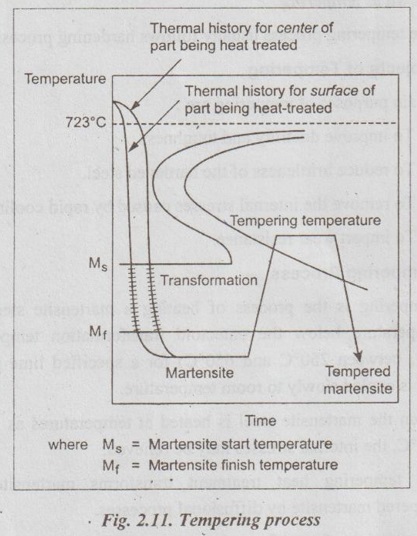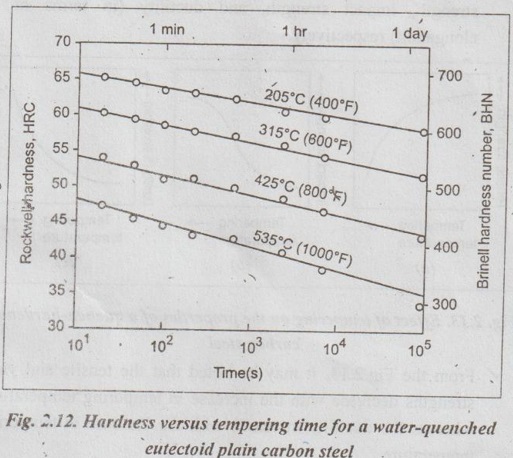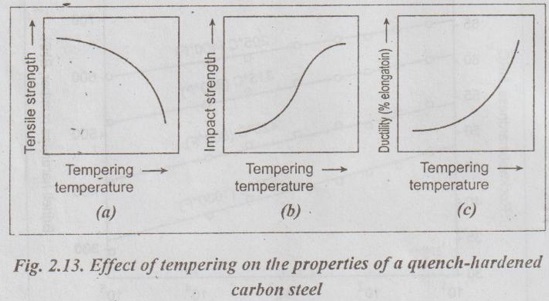The martensite which is formed during hardening process is too brittle and lacks good ductility and toughness.
TEMPERING
1. What is Tempering?
✓ The martensite which is formed during hardening process is too brittle and lacks good ductility and toughness. Hence, it cannot be used for most applications. Also the internal residual stresses that are introduced during hardening have a weakening effect. The ductility and toughness of martensite can be enhanced and these internal stresses are relieved by a heat treatment process known as tempering.
✓ The tempering process usually follows hardening process.
2. Objects of Tempering
The main purposes of tempering are:
1. To improve ductility and toughness.
2. To reduce brittleness of the hardened steel.
3. To remove the internal stresses caused by rapid cooling.
4. To impart wear resistance.
3. Tempering Process
✓ Tempering is the process of heating a martensite steel at a temperature below the eutectoid transformation temperature (i.e., between 250°C and 650°C) for a specified time period, and is cooled slowly to room temperature.
✓ When the martensite steel is heated at temperatures as low as 200°C, the internal stresses may be relieved.
✓ The tempering heat treatment transforms martensite into tempered martensite by diffusional processes.
The reaction of transformation of tempered martensite can be written as

That is, in the tempering process the single-phase BCT martensite (which is supersaturated with carbon) transforms to the tempered martensite (composed of the stable ferrite and cementite phases), as indicated on the iron-iron carbide phase diagram.
✓ Tempered martensite have substantially improved ductility and bra toughness than the martensite.
4. Microstructural Changes in Martensite Upon Tempering

✓ The microstructure of tempered martensite consists of extremely small and uniformly dispersed cementite particles embedded within a continucus ferrite matrix.
✓ This is similar to the microstructure of spheroidite except that the cementite particles are much smaller.
✓ Fig.2.11 shows an electron micrograph of tempered martensite.
5. Effect of Tempering Temperature on the Hardness of Steels
✓ Fig.2.12 depicts the effect of increasing tempering temperature on the hardness of the several martensite steels.
✓ It may be seen from the Fig.2.12 that the hardness gradually decreases as the temperature is increased.

✓ This gradual decrease in hardness of the martensite with increasing temperature is mainly due to the diffusion of carbon atoms from their stressed interstitial lattice sites to form second-phase iron carbide precipitates.
6. Effect of Tempering Time on the Hardness of Steels
✓ The effect of tempering time on the hardness of steels is also shown in Fig.2.12.
✓ It may be seen from the Fig.2.12 that the hardness decreases. with the increase in tempering time.
7. Effect of Tempering Temperature on Mechanical Properties
✓ Fig.2.13 (a), (b) and (c) illustrate the effect of tempering temperature on the mechanical properties such as tensile strength, impact strength, and ductility (in terms of % elongation) respectively.

✓ From the Fig.2.13, it may be noted that the tensile and yield strengths decrease with the increase in tempering temperature, whereas the ductility increases with the increase in tempering temperature.
✓ The above changes are mainly due to the fact that increasing nod to the temperature will accelerate diffusion, the rate of cementite particle growth, and hence the rate of softening.
8. Classification of Tempering
According to the tempering temperature, tempering may be classified into three classes. They are:
1. Low Temperature Tempering
✓ The low temperature tempering is performed in the temperature range from 150°C to 250°C.
✓ This process is used to retain hard microstructure of martensite. Also this process relieves the internal residual stresses.
✓ This process is generally applied on cutting and measuring Tootools of carbon and low alloy steels and the parts which are surface hardened and case-carburised.
2. Medium Temperature Tempering
✓ The medium temperature tempering is performed in the temperature range from 350°C to 450°C.
✓ This process develops tempered-troostite structure.
✓ This process increases endurance limit and elastic limit.
✓ This process is applied on spring steels and die steels.
3. High Temperature Tempering
✓ The high temperature tempering is performed in the temperature range from 500°C to 650°C.
✓ This process develops sorbite structure.
✓ It eliminates the internal stresses completely.
✓ This process is applied on structural steels.
Note
✓ The tempering of some steels/steel alloys may result in a reduction of toughness (i.e., increase in brittleness). This phenomenon is referred as temper embrittlement.
✓ The temper embrittlement occurs when the steel is tempered at a temperature above about 575°C followed by slow cooling to room temperature.
No comments:
Post a Comment